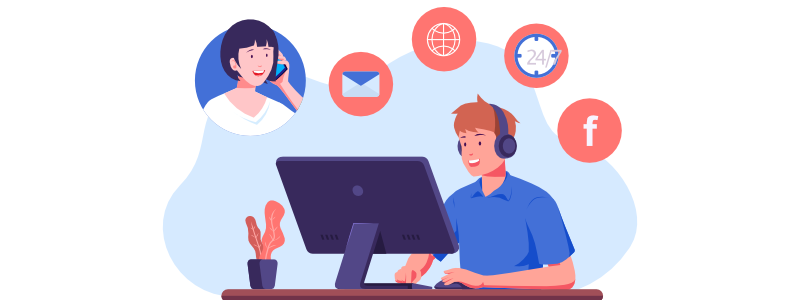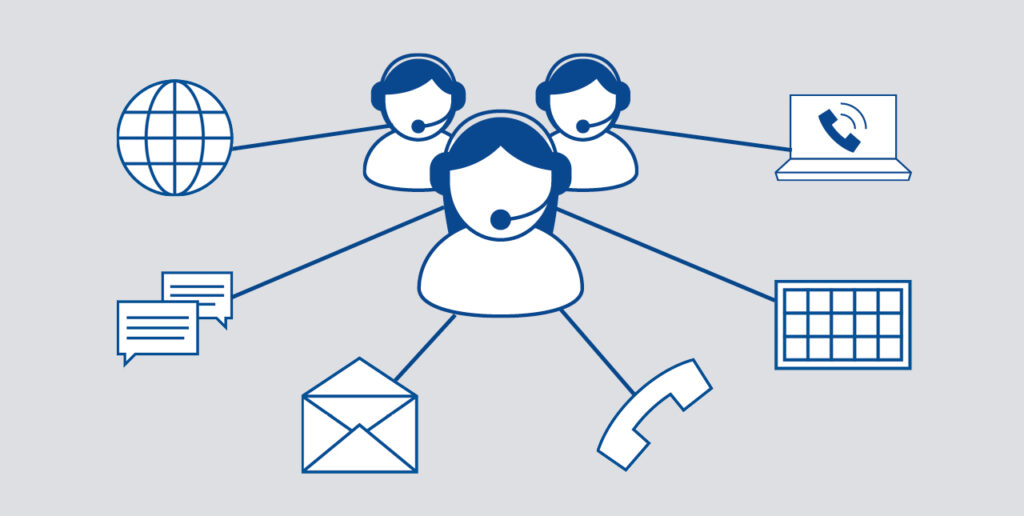What is the multichannel contact center for you in this article? We will answer your question. We’ll also better explain the differences between pricing and multichannel vs omnichannel.
What is a multichannel contact center?
A multi-channel contact center is a software platform that can integrate multiple managements – voice, text, or social media. A multi-channel contact center is similar to call center software, allowing your staff to connect with customers in more ways than one.
Multichannel contact center software service providers help you quickly connect with customers through a single software platform, no matter how they choose to communicate with you. In this way, you will ultimately increase work efficiency and customer satisfaction.
Typically, the cloud is also deployed as a central operating center, helping support and sales representatives interact through digital channels outside of a standard call center and specifically call forwarding. Unlike a multi-channel call center, where you can also influence different call channels, whether sales or repair, it refers to multi-channel communication with you. Customer interactions take place at the following point:
• Sound
• Interactive voice response
• Email
• Web chat
• Social media
• Text messaging
To provide the best customer experience, you can consider multi-channel customer support when customers have a channel they prefer outside of your existing voice setup. Research shows that many customers are also interacting with three to five different channels to solve demand. While voice remains the primary inbound support channel, you can’t ignore other popular methods like social media or SMS text messaging.
Which support channels should I integrate?

It is important to learn the channels preferred by customers. So how do you find out? Try asking your customers! You can meet with your customers or survey to learn the preferred communication channels to reach you. Thus, it will be easy for you to measure their reactions. You can tell if they make these choices, both genuinely and instinctively. If you are constantly experiencing high call volume, it would not make sense to add alternative channels for this. You can reduce the pressure on search queues by offering something different.
As an example of this, when client needs help with troubleshooting on their mobile phone, they do not always need to verbally talk to a consultant. Instead, you can redirect web chat queries to members of the call center or to experts in that area. They can even serve 3, 4, or 5 customers at the same time. This way you can meet customer needs and reduce call volumes as well.
Especially the Business VoIP Phone System uses have a truly miraculous use for you.
Multichannel contact center pricing
The beauty of multichannel contact center pricing is that you only must pay as much as you use. When many channel deployments are delivered via the cloud, this pricing model will also be standard. For example, if you need voice, email, and web chat, these are the only channels you need to pay for. You can purchase a subscription model accordingly.
You can even choose all channels that are multi-channel. It is also possible to request to open incoming channels for call centers that want to help their customers at every point. Often companies also implement their omnichannel approach in a phased manner. Therefore, they do not have to pay for digital channels that they do not need.
What is an omnichannel contact center?

An omnichannel contact center is a multi-channel contact center that helps you support customers who are on different channels at the same time. So, if your customer initiates a request from an online chat and then searches to get an update, agents will have access to the same information. In this way, the interview continues more healthily.
Omnichannel, which is also deployed as a hosted contact center, empowers contact center representatives to keep customer information across customers’ communication channels. What happens here is that your customer journey fails in the initial block because you assume your customers will only use one channel at a time.
For this reason, talking to your customers is a very important point in contact center planning. It’s also another great reason to record customer calls to measure customer satisfaction beyond statistics.
Putting your customers’ needs at the forefront of your contact center means happier customers for you. It will result in better customer retention. For example, since you’ve always operated as a call center, a phone call can still be one of the most used channels. But does this mean that customers only use voice when communicating with you?
Perhaps your customers will also try your website by looking for a web chat window or support email address. Your customers may even want to use social media networks to ask for help. In short, customer expectations are that you support them where they hang out.
Omnichannel contact center pricing
When you look at omnichannel usage, it may sound like multichannel. But while there isn’t much difference between omnichannel and multichannel, there is a difference. The biggest difference between them is that they provide seamless migration from one environment to another. Another difference is the price distinction.
In general, user seats are available at approximately the same price, depending on the number of channels. However, omnichannel functionality is more costly in terms of familiarization and access to advanced cross-channel integrations.
Omnichannel licenses average $100 per user, depending on the customization. Of course, it will be more advantageous to meet with your experts to get the right price.
What is the difference between omnichannel and multichannel?
There are subtle differences between omnichannel and multichannel contact center software. However, when looked at collectively, they have left the call centers in the past. The main difference is that it offers automation across omnichannel channels. This capability makes channel support autonomous and easy for both your customers and your agents.
When evaluating omnichannel vs. multichannel, it’s important to focus on how customers are working as well. Customers can also have multiple touchpoints in their journey. In such cases, you may want to consider using omnichannel.

12 responses